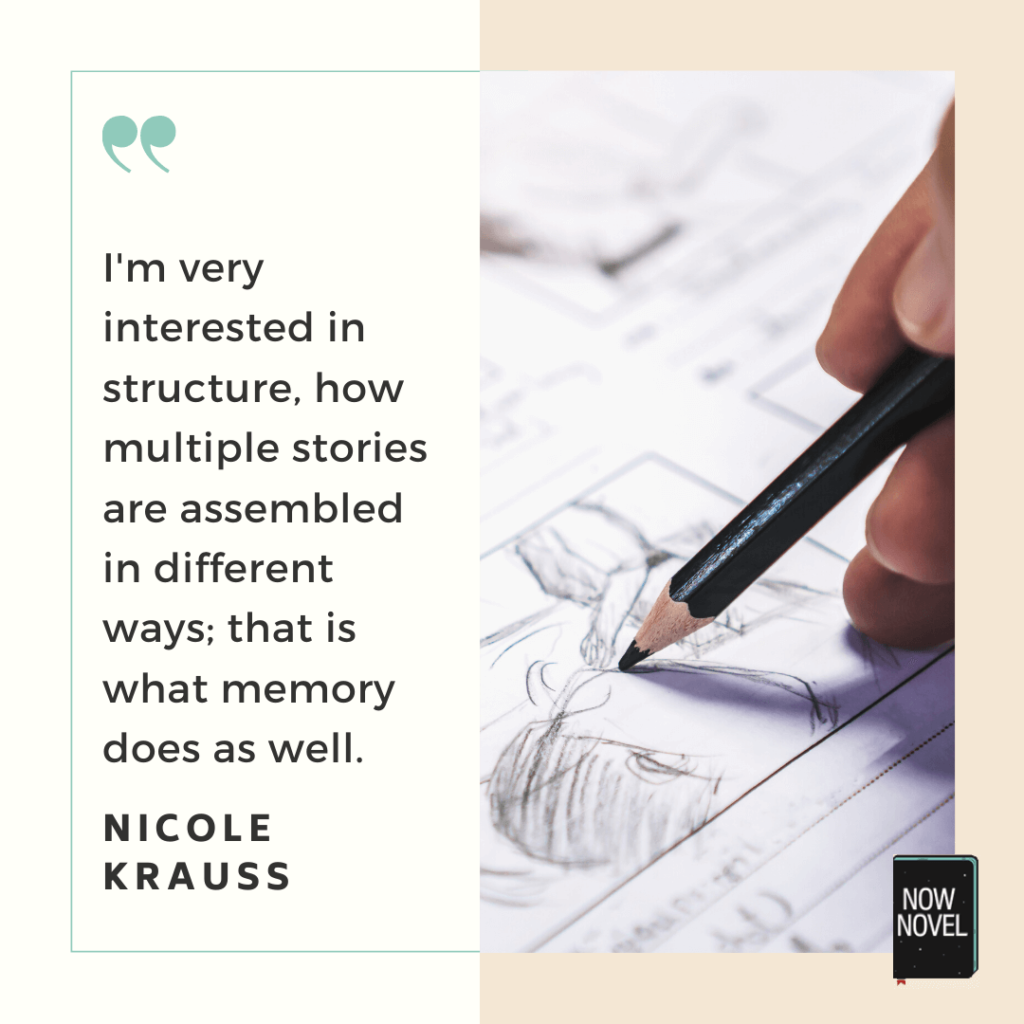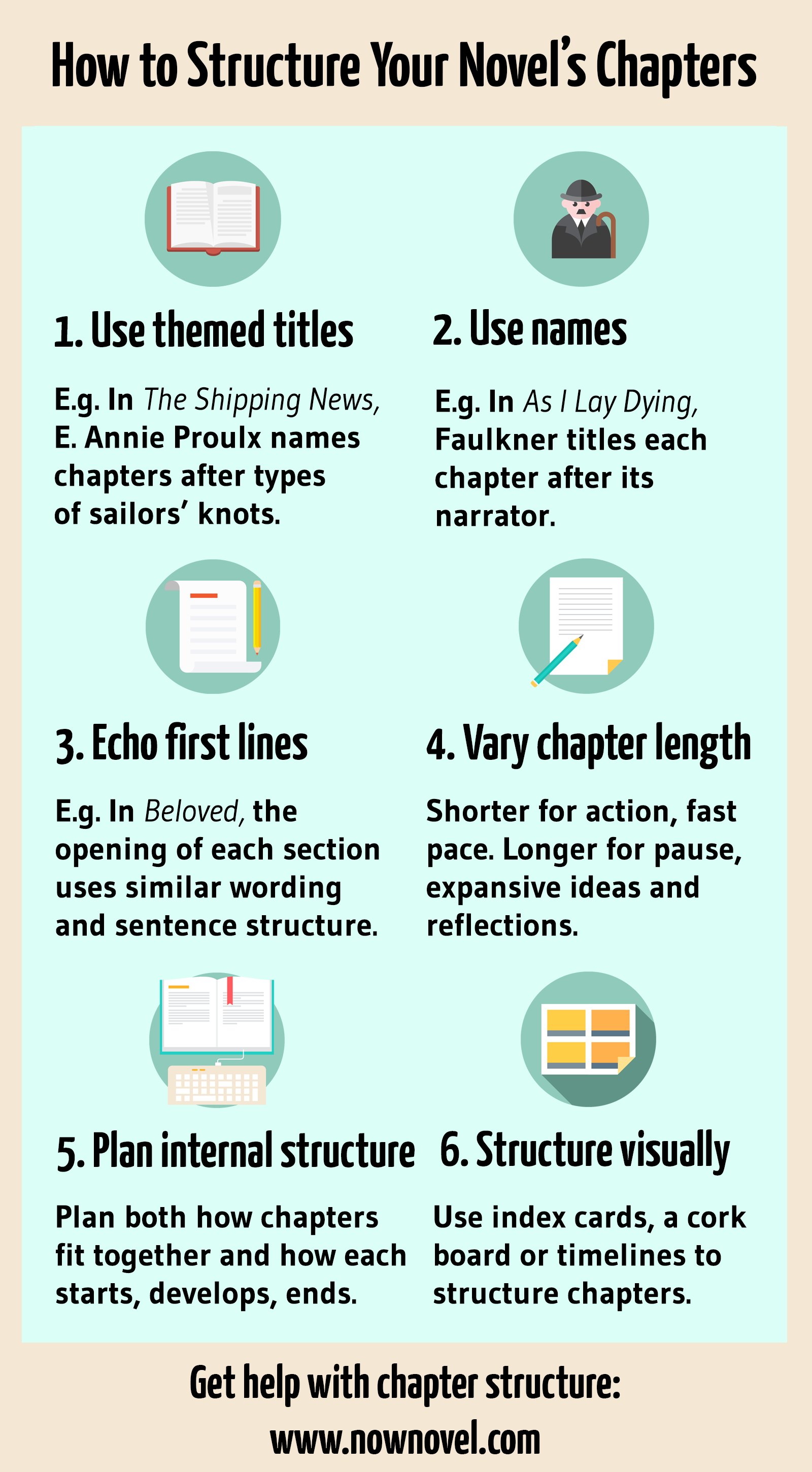The structure of a novel is important because it contributes to the clarity and flow of your story. Chapter structure is satisfying when the beginning, development and end contribute equally to the whole. Read 7 tips to write well-structured chapters, including examples from great fiction:
First, what do book chapters do?
It's easy enough to read a short story in a single sitting. It might take place in a single house in a single small town. Maybe it shows a character planning a party (or hiding a body). In a longer work of fiction, chapter breaks serve important purposes:
- They give the reader space to pause and digest the information of the preceding chapter or scene.
- They signal transition: A change in story location, a character embarking on a new goal, or the closing of one story arc and the start of another.
Dividing your story into related sections that make sequential sense gives readers a more structured, digestible experience.
Just as you should structure individual scenes well, you should apply this focus to your broader chapters.
Here are 7 useful ideas for how to structure a novel:
1. Use thematically relevant titles that connect to your story
Titles give cohesion to novels and short stories. Many authors don't use chapter titles, and some novels don't have chapter breaks at all, using unstructured presentation for creative effect.
For example, a book about a character losing their mind might begin with clear chapter structure, only to become disjointed to reflect the protagonist's emotional state.
Chapter titles can contribute useful structure, however. A title may:
- Hint what the coming chapter is about
- Summarise (overtly or subtly) important themes or ideas in your story
- Give useful information (such as a date or geographic location), helping the reader to understand where (or when) the events of your chapter occur
Consider this example: E. Annie Proulx's Pulitzer-winning novel, The Shipping News (1993).
Proulx's story follows the trials of Quoyle, a reporter who moves with his children to the island of Newfoundland following a disastrous relationship.
Many of Proulx's chapter titles are structured around the maritime themes of the novel. Several chapters are named after knots traditionally used by sailors.
The second chapter, 'Love Knot', for example, details Quoyle's disastrous relationship with his children's mother, Petal Bear. The chapter title is excellent because it conveys what the chapter will be about (difficult, i.e. 'knotty' love).
Proulx extends the implications of her title further with a subtitle in italics explaining what a 'love knot' is:
In the old days a love-sick sailor might send the object of his affections a length of fishline loosely tied in a true-lover's knot. If the knot was sent back as it came the relationship was static. If the knot returned home snugly drawn up the passion was reciprocated. But if the knot was capsized - tacit advice to ship out.
Chapter title and subtitle thus give us a good indication of what to expect.

2. Use chapter titles to structure your story in different ways
In a guest post for Helping Writers Become Authors, Bryan Wiggins outlines 3 crucial purposes of chapter names:
1. Attracting the attention of readers
2. Finding and emphasizing each chapter's focus
3. Orienting your fictional world and creating signposts that guide readers through your story.
There are many different ways to name chapters.
A literary novel that doesn't have any singular important theme or location might simply have numbered chapters.
If, however, your novel is a historical epic spanning multiple countries and continents, consider beginning each chapter with the setting/location: 'Paris, France' or 'Boston, Massachussets'. This immediately anchors the story to a particular place.
In novels where point of view (or POV) alternates between characters, you can start each chapter with the name of the character who is telling the story. This is what Faulkner does in As I Lay Dying (more on Faulkner's chapter structure below).
This device immediately indicates who is narrating. It leaves you free to use the first person without having to identify the narrator continuously.
In Michael Cunningham's A Home at the End of the World, a novel about a triangular relationship between two men and a woman, this titling approach is used to present each different character's desires, fears, and perceptions of the others.
Alternatively you can use chapter titles to draw readers' attention to important themes or events.
In Virginia Woolf's famous novel To the Lighthouse, a central section written from the point of view of time is simply called 'Time Passes'. Each chapter within the section is then numbered starting from 1.
3. Start a chapter in a story with structure-enhancing links
Besides using titles, you can also structure your chapters by paying careful attention to how they start, develop and end.
Consider this example of a well structured book:
In Toni Morrison's Pulitzer-winning novel Beloved (1987), the first chapter begins '124 was spiteful.' This brief opening sentence is echoed in the opening of the book's middle section: '124 was loud'.
Each of these chapter openings echoes each other, referring to the street number of the house that is the setting for much of the story. This recurring opening structure creates a sense of something cyclical and menacing.
This mirrored opening structure mimics something cyclical about the nature of ghosts (a fundamental symbol of the story) and trauma (specifically, in Beloved, the trauma of slavery). The structure draws our attention to the cyclical effects of major personal and historical trauma, as it returns to take its toll.
Think of echoes you can create backwards and forwards through your story by structuring chapter openings around recurring ideas, symbols or themes (e.g. love, loss, renewal, tyranny, etc.)
4. Think about how long each chapter should be
Short, action-heavy chapters help to speed up the pace. Longer, reflective chapters that linger over setting or historical description give the reader a breather.
Longer chapters can make your story lose a sense of direction if they're unfocused. To avoid this, make sure you structure longer chapters around pivotal character goals, encounters and developments. Make sure every scene has a specific purpose for your overarching story.
The length of a chapter should suit its purpose. A brief chapter that is only a page long (or even just a paragraph or two) can be used to poetic or dramatic effect, reinforcing the significance of an event. Unless the plot requires otherwise, aim for shorter rather than longer chapters. Many readers will appreciate being given manageable chunks of your story as opposed to an overwhelming slab of text.
Consider the following example from William Faulkner's acclaimed novel, As I Lay Dying (1930).
The novel describes the Bundren family's quest to bury their mother Addie in her hometown of Jefferson, MIssissippi, after she dies. 15 different characters narrate the story over its 59 chapters. Some chapters are as short as a page. For example, a chapter narrated by the eldest Bundren son, Cash, is only 13 points in a numbered list, as Cash describes how he made Addie's coffin:
I made it on the bevel.
1. There is more surface for the nails to grip.
2. There is twice the gripping-surface to each seam.
3. The water will have to seep into it on a slant. Water moves easiest up and down or straight across.
The short, list-structured chapter is effective for multiple reasons:
- It shows Cash's methodical, responsible nature and ability as a carpenter
- It shows the single-minded focus and care the family take over Addie's burial preparations.
Faulkner gives us two crucial story elements in his concise, structured chapter. We get insight into Cash's thoughtful and methodical character and a vital quest object - the casket the family ferries, through great hardship, to Mississippi.
Play with chapter length. Structure your chapters so that they cover exactly what they need to move us from scene to scene and goal to goal.

5. Vary the length of your chapters for interesting novel structure
There's no single perfect chapter length. A lot depends on your genre. In a murder mystery or thriller, a chapter lasting 27 pages that includes extensive setting description will reduce pace. Long, meandering chapters might convey epic historical time, whereas shorter chapters keep the pace taut and tense, the time now.
One of the best ways to keep scenes interesting is to vary sentence length. Short sentences stand out. Longer sentences can be lyrical or can communicate something shorter ones can't. The same structural principles apply to chapters. Vary their length according to the tone and overall effect you want to achieve. Is a team of crack policemen closing in on the perpetrator in your crime novel? Shorter chapters at this pivotal time can create a sense of mounting tension, threat and anticipation.
To recap, the ideal length of your chapter depends on:
- Your genre and its conventions
- The pace and mood you want to create
6: Think about broader structure alongside individual chapters
When creating an outline or revising your novel for better flow and structure, think about the broad structure of your novel. Also think about the internal structure of individual chapters.
To create great internal chapter structure:
a) Begin with purpose and direction
The start of a chapter serves several important functions:
- Roping the reader into the scene
- Creating continuity or a shift from the previous section (a change in point of view, time period, setting or style)
- Giving readers an idea of what the focus of the next part of your story will be
A strong chapter opening is key, especially at the start of your novel. Chuck Wendig at Terrible Minds states that the first line is all important because if the reader says 'that line was so damn good I'm in for the next 50 pages', there is immediate commitment. Wendig makes a great analogy when he says 'A good opening line is a stone in our shoe that we cannot shake.' He describes the first chapter of a book as 'the gateway drug to the second chapter'.
There are multiple ways to begin a chapter:
1. Starting in medias res (in the thick of action). This can avoid unnecessary introductory waffle that bores readers. As Glen Strathy says, 'Too often, novice writers start their stories with unnecessary preamble that bores a reader and makes him stop reading.'
2. Scene-setting - Beginning with a vividly painted scene is useful (particularly in genres such as historical romance) as it helps readers obtain a mental picture of an unfamiliar place and/or era.
3. Beginning a chapter with dialogue creates immediate questions that beg answers: 'Who is speaking? What are they talking about? What is their relationship?' Good dialogue thus creates a great pull towards further discovery.
When beginning a chapter, ask yourself these questions:
- Do I have a strong enough hook to make the chapter appealing?
- Does it follow on from the previous chapter logically (will readers be able to follow the story's thread from chapter to chapter?)
- Do I have a clear sense of what the chapter should contribute to the story?
Consider writing a brief two-line summary before you start each chapter.
For a revenge saga, for example, you might write 'In this chapter the reader will learn the villain's motivation for killing the main character's family'.
Having a guiding sense of purpose will help you avoid wasting time writing scenes you'll axe in your final draft.
b) Ensure your chapter develops satisfyingly
A well structured chapter edifies us about the story to come. We are further along the story arc by the time the chapter is over, even if all that means is we know more about Cash's personality (to return to the Faulkner example) and the vital features of his mother's lovingly-made casket.
To structure your chapter's development, ask:
- What chain of events does the chapter's opening set in motion?
- What changes might take place in the '5 Ws' of story (who, what, why, where, or when) as the chapter unfolds?
c) Write an ending that strengthens chapter structure
Ending chapters is often challenging. Once you have momentum going, it can be hard to leave off a scene. Aaron Elkins, at Writer's Digest, suggests splitting a story into chapters whenever a story shift occurs. Says Elkin, 'Changes of place, changes of time and changes of point of view are all excellent places for chapter breaks.'
Here are some places where it makes sense to create a break. Some might seem more obvious than others:
- Just before the climax of a significant story arc: This is a classic trick of the thriller and mystery novel. Just when the reader has reached a tense moment she has to turn the page.
- After the climax of a significant event: If you have given the reader unrelenting tension and eventfulness, bringing a minor arc to an end provides an ideal moment to let the reader relax before new intrigues begin.
- Immediately after a development between two characters: An ending creates a sense of significance around it. A character might tell a secondary character fact about themselves or their history. By creating a pause with a chapter break, you signal to the reader that this information was important.
7. Use outlines and other organising tools
When it comes to creating story structure, an outline is extremely useful.
Being able to think of chapters as summary-form story units that you can move around as you want gives you freedom to move around the story's parts.
Vladimir Nabokov, for example, wrote on index cards and would rearrange the chapters he wrote by shuffling the cards until he found a sequence that made sense as a whole.
Make time-lines for individual scenes and individual chapters, distilling the events of each unit into a few words. This is a very useful exercise when you have finished writing a first draft and want to knit your story together more precisely.
Whatever approach you use to structure and arrange chapters, planning what each chapter will cover before you start will give your story a sense of direction and purpose Understanding how to write a chapter well will help readers fall into the rhythm of your novel.
Want better structure in your story? Use the Now Novel dashboard to build a structured idea of your premise, characters, plot, setting and more in easy steps.









I think the best writing advice I've found on writing chapters is contained within this post ;-) Honestly, I've not seen this topic covered in many text books. I guess this approach focuses on creating a structure, not dissimilar to scene structure, but which operates discreetly to control pacing, progression, and so forth. Sharing this – it's excellent!
Adrian Tannock - Over 9 years ago
Thanks so much for the kind feedback, Adrian. I'm glad you found this post useful! Thanks for sharing too. Yes I think structure can achieve all kinds of interesting effects, we often focus on the words themselves to the exclusion of considering structure and other equally important elements.
Bridget At Now Novel - Over 9 years ago
As always, interesting concepts to try and perhaps use. Personally I have always found when reading a novel that chapter titles tend to make the story more like a screenplay.
Bob Fairfield - About 8 years ago
Thanks, Bob. Fair point - not everyone enjoys a very visible type of structuring. Thank you for reading and sharing your thoughts.
Bridget At Now Novel - About 8 years ago
Thanks for the post I really enjoyed it and learnt a lot on the structuring chapters
Chinedummaduebo - About 8 years ago
I'm glad to hear it. Thanks for reading and for the feedback.
Bridget At Now Novel - About 8 years ago
Thank you so much for this post. It is awesomely compact! Very educational. Now, I feel confident to pick up my pen and face my story.
Dera - Almost 5 years ago
That's great to hear, Dera. It's a pleasure! Good luck with your story.
Jordan - Almost 5 years ago
Thanks for this useful information. I have three main protaganists who I alternate consistently through the novel and the book is structured over thirteen months. I was not sure whether each month was a chapter or each change in POV. This info has helped me decide. It will be POV.
Carla Simmons - Over 4 years ago
Hi Carla, it's a pleasure. I'm glad this was useful to your curent novel! That's a classic strategy and works very well for creating a multi-voiced novel, in my opinion. Good luck as you proceed further.
Jordan - Over 4 years ago
This is super! Wonderful examples!
L.A. Kurt - Over 4 years ago
That's great to hear, L.A. Thank you for reading!
Jordan - Over 4 years ago
This is an excellent article, thank you for posting it. I'll now concentrate more on structure before diving into the detail of writing. It makes the daunting process of writing a novel more manageable.
Alan - Over 3 years ago
Hi Alan, it's a pleasure - thank you for reading it and taking the time to share feedback. Have fun with your current WIP and all the best for 2022!
Jordan - Over 3 years ago
thanks a lot as i am writing my first novel and i hope everyone will like it as i take your thoughts as my actions and at the right time i got this msg thanks to your thoughts all the best pls do post more like this for young writers like me
Amru - About 3 years ago
Hi Amru, it's great you're writing your first novel. Good luck and thanks for reading our blog. You'll find other young writers to share mutual feedback with in our free critique forums.
Jordan - About 3 years ago
I'm lucky to have found this post. I find it very useful and thanks for the sharing it.
Chinenye Ubah - Over 2 years ago
Hi Chinenye, thank you for your kind feedback and for reading our blog, I'm glad you found this article useful.
Jordan - Over 2 years ago
This post has, in my opinion, the best writing advice I've come across for creating chapters. To be honest, I haven't seen many textbooks address this subject. This method, I suppose, is centered on developing a structure that functions covertly to regulate pacing, progression, and other aspects, much like scene structure. I'm sharing this because it's great!
Purav Jha - Over 1 year ago
Thanks so much for writing in Purav, your comments are appreciated. So pleased that you have found the blog post super useful!
Arja Salafranca - Over 1 year ago